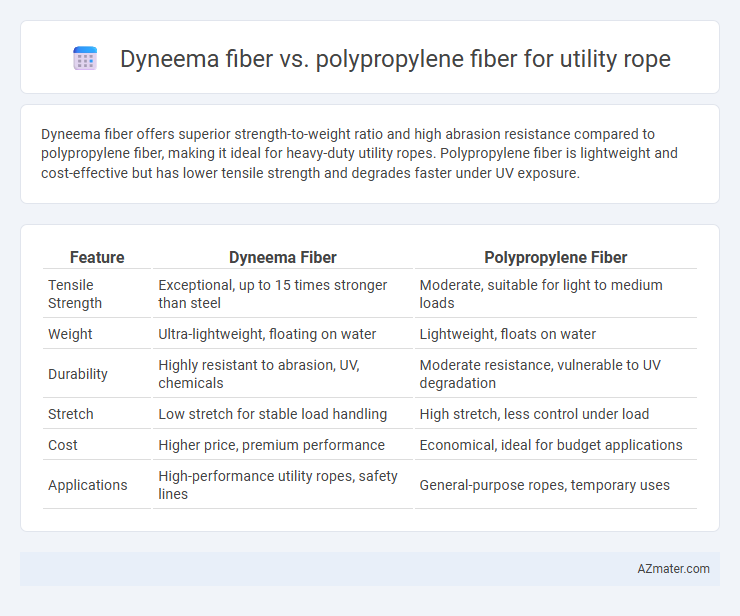Dyneema fiber offers superior strength-to-weight ratio and high abrasion resistance compared to polypropylene fiber, making it ideal for heavy-duty utility ropes. Polypropylene fiber is lightweight and cost-effective but has lower tensile strength and degrades faster under UV exposure.
Table of Comparison
| Feature | Dyneema Fiber | Polypropylene Fiber |
|---|---|---|
| Tensile Strength | Exceptional, up to 15 times stronger than steel | Moderate, suitable for light to medium loads |
| Weight | Ultra-lightweight, floating on water | Lightweight, floats on water |
| Durability | Highly resistant to abrasion, UV, chemicals | Moderate resistance, vulnerable to UV degradation |
| Stretch | Low stretch for stable load handling | High stretch, less control under load |
| Cost | Higher price, premium performance | Economical, ideal for budget applications |
| Applications | High-performance utility ropes, safety lines | General-purpose ropes, temporary uses |
Introduction to Utility Rope Materials
Utility rope materials significantly impact performance, with Dyneema fiber offering exceptional tensile strength and low stretch, making it ideal for heavy-duty applications requiring durability and reliability. Polypropylene fiber provides a lightweight, cost-effective solution with good resistance to moisture and chemicals but lacks the high strength and abrasion resistance of Dyneema. Choosing between Dyneema and Polypropylene fibers depends on the specific utility rope requirements such as load capacity, environmental exposure, and budget constraints.
Overview of Dyneema Fiber
Dyneema fiber, known as ultra-high-molecular-weight polyethylene (UHMWPE), offers exceptional strength-to-weight ratio, making it ideal for utility rope applications where high tensile strength and low weight are critical. Compared to polypropylene fiber, Dyneema provides superior abrasion resistance, minimal water absorption, and outstanding durability under harsh environmental conditions. Its molecular structure allows Dyneema ropes to maintain performance in both wet and dry environments, outperforming polypropylene ropes in longevity and safety.
Overview of Polypropylene Fiber
Polypropylene fiber is a lightweight, cost-effective material widely used in utility ropes due to its excellent resistance to moisture, chemicals, and UV exposure. Its low density ensures buoyancy, making it ideal for marine applications, while its moderate strength and flexibility provide adequate performance for general utility purposes. Despite being less strong and durable than Dyneema fiber, polypropylene remains a popular choice for budget-friendly, versatile ropes in various industrial and recreational settings.
Strength Comparison: Dyneema vs Polypropylene
Dyneema fiber exhibits exceptionally high tensile strength, often outperforming polypropylene fiber by up to 15 times, making it ideal for heavy-duty utility ropes requiring maximum load capacity. While polypropylene offers cost efficiency and water resistance, its lower strength limits its use in high-stress applications compared to Dyneema's superior durability and resistance to abrasion. The strength-to-weight ratio of Dyneema fiber is significantly higher, providing enhanced safety and longevity in demanding utility rope environments.
Durability and Abrasion Resistance
Dyneema fiber offers superior durability and abrasion resistance compared to polypropylene fiber, making it ideal for heavy-duty utility ropes exposed to harsh environments. Its ultra-high molecular weight polyethylene (UHMWPE) structure provides exceptional strength-to-weight ratio and outstanding resistance to cuts, wear, and UV damage. Polypropylene fibers, while more affordable and lightweight, degrade faster under abrasion and environmental stress, reducing the rope's lifespan in demanding applications.
Water Resistance and Floatation Properties
Dyneema fiber exhibits exceptional water resistance due to its low moisture absorption rate, maintaining strength and durability even after prolonged water exposure, making it ideal for utility ropes used in marine environments. Polypropylene fiber boasts superior floatation properties because its density is lower than water, allowing ropes made from it to float naturally, which is beneficial for rescue operations and surface marking. Both fibers offer distinct advantages where Dyneema excels in water resistance and durability, while Polypropylene provides unmatched buoyancy for utility rope applications.
Weight and Handling Characteristics
Dyneema fiber offers superior strength-to-weight ratio, making utility ropes significantly lighter and easier to handle compared to polypropylene fiber ropes, which are heavier and bulkier. Dyneema's low stretch and smooth texture enhance knot and grip reliability, while polypropylene ropes tend to absorb water and become slippery when wet, reducing handling efficiency. The low weight of Dyneema ropes minimizes fatigue during prolonged use, improving overall safety and performance in utility applications.
UV and Chemical Resistance
Dyneema fiber offers superior UV resistance, maintaining strength and flexibility when exposed to prolonged sunlight, making it ideal for outdoor utility rope applications. Polypropylene fiber, while lightweight and cost-effective, degrades faster under UV exposure, losing tensile strength and becoming brittle over time. Chemically, Dyneema demonstrates high resistance against most acids, alkalis, and solvents, whereas polypropylene is more vulnerable to chemical attack, limiting its durability in harsh environments.
Cost and Availability Analysis
Dyneema fiber offers exceptional strength and durability for utility ropes but comes at a significantly higher cost compared to polypropylene fiber, which is more affordable and widely available. Polypropylene's abundant production and lower price point make it a preferred choice for budget-conscious applications despite its lower tensile strength and UV resistance. Cost efficiency and widespread availability keep polypropylene dominant in general utility rope markets, whereas Dyneema is favored for high-performance, specialized uses.
Best Applications for Each Fiber Type
Dyneema fiber excels in utility ropes requiring high strength-to-weight ratio, superior fatigue resistance, and minimal stretch, making it ideal for marine mooring, climbing ropes, and industrial lifting slings. Polypropylene fiber offers excellent water resistance, low cost, and buoyancy, which suits applications such as water rescue ropes, general-purpose utility cords, and temporary tie-downs. Selecting Dyneema ensures maximum durability and load capacity, while polypropylene fibers prioritize affordability and flotation characteristics.

Infographic: Dyneema fiber vs Polypropylene fiber for Utility rope
 azmater.com
azmater.com